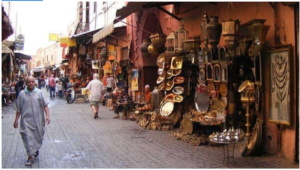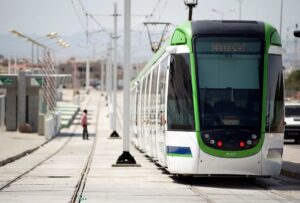
Morocco lies directly across the Strait of Gibraltar from Spain. It’s largest city and major Atlantic Ocean port is Casablanca, an industrial and commercial centre. The capital, Rabat, lies a short distance to the north on the Atlantic coast.
Other port cities include Tangier, on the Strait of Gibraltar, Agadir, on the Atlantic, and Al-Hoceïma, on the Mediterranean Sea. The city of Fès is said to have some of the finest souks, or open-air markets, in all of North Africa.
Scenic and fertile, Morocco well merits the praise of a native son, the medieval traveller Ibn Battuta, who wrote that “it is the best of countries, for in it fruits are plentiful, and running water and nourishing food are never exhausted.”
The country is rapidly modernizing and enjoys a rising standard of living, it retains much of its ancient architecture and even more of its traditional customs.
It has also been subject to extensive migration and has long been the location of urban communities that were originally settled by peoples from outside the region. Controlled by Carthage from an early date, the region was later the westernmost province of the Roman Empire.
Capital: Rabat
Currency: Moroccan dirham
Language: Arabic
Population: Morocco Population (2024)
Religion: Islam
Tax rate: PwC’s summary on Moroccan corporate taxes ( Worldwide Tax Summaries Online )
Crime Rate
The crime rate in Morocco is moderate, with increasing crime rates in the past five years. Worries about various crimes, such as muggings, car theft, and property crimes, fall into the moderate range. Crime in Morocco
GDP
As of 2024, Morocco’s Gross Domestic Product (GDP) is projected to grow by 3.2%, up from an estimated 2.9% in 2023. This growth is driven by various economic measures and the implementation of the 2024 Finance Act, which aims to address socio-economic challenges such as inflation, drought, and earthquake impacts. The nominal GDP is anticipated to increase by 6% in 2024, contributing to an inflation rate of 2.8% as measured by the GDP deflator (Maroc) (IMF).
Openness to tourist
Morocco remains highly open and welcoming to tourists. The country experienced a significant increase in tourist arrivals, with 2.1 million visitors in the first two months of 2024 alone, marking a 14% growth from the previous year. This growth trend is expected to continue, with projections indicating a 15% increase in tourism by the end of 2024. The government has been focusing on enhancing marketing efforts and improving air connectivity to attract more visitors. https://www.visitmorocco.com/en/travel-info/covid-19-travel-safely-to-morocco
Image of the Medina Street in Marrakech, one of Morocco’s most popular tourist destinations – PHOTO/FILE
Climate

Taylor McIntyre / Trip Savvy
Morocco is a land of contrasts. Bathed to the north by the waters of the Mediterranean, to the west by those of the Atlantic Ocean, it is also criss-crossed by the Rif and Atlas Mountains and is subject to all sorts of climatic influences. Britannica
Employment rate
Employment Rate in Morocco decreased to 36.70 percent in the first quarter of 2024 from 38 percent in the fourth quarter of 2023. Employment Rate in Morocco averaged 43.68 percent from 1999 until 2024, reaching an all time high of 48.00 percent in the first quarter of 1999 and a record low of 36.70 percent in the first quarter of 2024. Morocco Employment Rate – Trading Economics
Cost of Living
Cost of Living in Morocco
Modes of Transport
Rabat – Morocco is a diverse country whose borders extend from the northernmost coasts of Tangier to the southern Saharan sands of Dakhla and transportation is not always straightforward. Moroccans utilize a wide array of modes of transportation to traverse the vast countryside.

Petit Taxi, Morocco
The most prominent modes of transportation for inner-city travel in Morocco are petit taxi (taxi Saghir), grand taxi (taxi Kabir), Careem, the city bus, and even a tramway system in Rabat and Casablanca. As for long distance travel, Morocco offers an extensive train system as well as regional bus routes, grand taxi routes, and a growing domestic air travel industry. Getting around in Morocco
MOROCCO VISA REQUIREMENTS
Most travellers from Europe, North America, and certain countries in Asia and the Middle East do not need a visa for stays up to 90 days. To get more information on the visa requirement in Morocco, visit (Infinite Morocco)
Morocco lies directly across the Strait of Gibraltar from Spain. It’s largest city and major Atlantic Ocean port is Casablanca, an industrial and commercial centre. The capital, Rabat, lies a short distance to the north on the Atlantic coast.
Other port cities include Tangier, on the Strait of Gibraltar, Agadir, on the Atlantic, and Al-Hoceïma, on the Mediterranean Sea. The city of Fès is said to have some of the finest souks, or open-air markets, in all of North Africa.
Scenic and fertile, Morocco well merits the praise of a native son, the medieval traveller Ibn Battuta, who wrote that “it is the best of countries, for in it fruits are plentiful, and running water and nourishing food are never exhausted.”
The country is rapidly modernizing and enjoys a rising standard of living, it retains much of its ancient architecture and even more of its traditional customs.
It has also been subject to extensive migration and has long been the location of urban communities that were originally settled by peoples from outside the region. Controlled by Carthage from an early date, the region was later the westernmost province of the Roman Empire.
Capital: Rabat
Currency: Moroccan dirham
Language: Arabic
Population: Morocco Population (2024)
Religion: Islam
Tax rate: PwC’s summary on Moroccan corporate taxes ( Worldwide Tax Summaries Online )
Crime Rate
The crime rate in Morocco is moderate, with increasing crime rates in the past five years. Worries about various crimes, such as muggings, car theft, and property crimes, fall into the moderate range. Crime in Morocco
GDP
As of 2024, Morocco’s Gross Domestic Product (GDP) is projected to grow by 3.2%, up from an estimated 2.9% in 2023. This growth is driven by various economic measures and the implementation of the 2024 Finance Act, which aims to address socio-economic challenges such as inflation, drought, and earthquake impacts. The nominal GDP is anticipated to increase by 6% in 2024, contributing to an inflation rate of 2.8% as measured by the GDP deflator (Maroc) (IMF).
Openness to tourist
Morocco remains highly open and welcoming to tourists. The country experienced a significant increase in tourist arrivals, with 2.1 million visitors in the first two months of 2024 alone, marking a 14% growth from the previous year. This growth trend is expected to continue, with projections indicating a 15% increase in tourism by the end of 2024. The government has been focusing on enhancing marketing efforts and improving air connectivity to attract more visitors. https://www.visitmorocco.com/en/travel-info/covid-19-travel-safely-to-morocco

Image of the Medina Street in Marrakech, one of Morocco’s most popular tourist destinations – PHOTO/FILE
Climate
Taylor McIntyre / Trip Savvy
Morocco is a land of contrasts. Bathed to the north by the waters of the Mediterranean, to the west by those of the Atlantic Ocean, it is also criss-crossed by the Rif and Atlas Mountains and is subject to all sorts of climatic influences. Britannica
Employment rate
Employment Rate in Morocco decreased to 36.70 percent in the first quarter of 2024 from 38 percent in the fourth quarter of 2023. Employment Rate in Morocco averaged 43.68 percent from 1999 until 2024, reaching an all time high of 48.00 percent in the first quarter of 1999 and a record low of 36.70 percent in the first quarter of 2024. Morocco Employment Rate – Trading Economics
Cost of Living
Cost of Living in Morocco
Modes of Transport
Rabat – Morocco is a diverse country whose borders extend from the northernmost coasts of Tangier to the southern Saharan sands of Dakhla and transportation is not always straightforward. Moroccans utilize a wide array of modes of transportation to traverse the vast countryside.
Petit Taxi, Morocco
The most prominent modes of transportation for inner-city travel in Morocco are petit taxi (taxi Saghir), grand taxi (taxi Kabir), Careem, the city bus, and even a tramway system in Rabat and Casablanca. As for long distance travel, Morocco offers an extensive train system as well as regional bus routes, grand taxi routes, and a growing domestic air travel industry. Getting around in Morocco
MOROCCO VISA REQUIREMENTS
Most travellers from Europe, North America, and certain countries in Asia and the Middle East do not need a visa for stays up to 90 days. To get more information on the visa requitement in Morocco, visit (Infinite Morocco)











